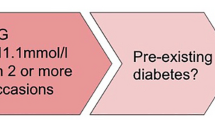Abstract
Urinary excretion of various renal prostaglandins was measured by radioimmunoassay and gas chromatography-mass spectrometry in children who had different degrees of metabolic control. Excretion in PGE2 in diabetic children was twice control values irrespective of the presence or absence of diabetic ketoacidosis (DKA). The urinary excretion of PGF2α was significantly increased in diabetic children with ketoacidosis, but not when diabetes was well controlled. The excretion of 13, 14 dihydro-15-keto PGE2, the major metabolite of circulating PGE2, was increased in all diabetic children, and was most elevated in ketoacidosis when it averaged 10 times basal excretion. Urinary excretion of PGI2α and of 6-keto-PGF1α, the metabolite of PGI2, was approximately doubled in DKA compared with values from healthy subjects. Excretion of PGE2 was twice control values in children with stable diatetes, whereas the equivalent value for TXB2, the metabolite of the active vasoconstrictor TXA2, was reduced by approximately 50%. We suggest that the increased excretion of prostacyclin metabolite may result from a protective biological action on the kidney opposing other vasoconstrictor hormone activity. PGE2 appears not to be involved in this process. The highly elevated excretion of PGE2 metabolite may represent an activation of systemic PGE metabolism during DKA.
Similar content being viewed by others
References
Ballermann BJ, Levenson DJ, Brenner BM (1986) Renin, angiotensin, kinins, prostaglandins and leukotrienes. In: Brenner BM, Rector FC (eds) The Kidney. Saunders, Philadelphia, pp 281–340
Epstein M, Lifschitz MD, Hoffman DS, Stein JH (1979) Relationship between renal prostaglandin E and renal sodium handling during water immersion in normal man. Circ Res 45: 71–80
Leysace PP, Christensen P, Hill R, Skinner SL (1975) Indomethacin blockade of renal PGE-synthesis: effect on total renal and tubular function and plasma renin concentration in hydropenic rats and on their response to isotonic saline. Acta Physiol Scand 94: 484–496
Tulassay T, Rascher W, Körner A, Miltényi M (1987) Atrial natriuretic peptide and other vasoactive hormones during treatment of severe diabetic ketoacidosis in children. J Pediatr 111: 329–334
Miltényi M, Körner A, Tulassay T, Szabó A (1985) Tubular dysfunction in type 1 diabetes mellitus. Arch Dis Child 60: 929–931
Müller H, Mrongovius R, Seyberth HW (1981) Improved sample preparation for the quantitative mass spectrometric determination of prostaglandins in biological samples. J Chromatogr 226: 450–454
Kirschenbaum MA, Serros ER (1980) Effects of alterations in urine flow rate on prostaglandin E excretion in conscious dog. Am J Physiol 238: F107–111
Levenson DJ, Simmons CE, Brenner BM (1982) Arachidonic acid metabolism, prostaglandins and the kidney. Am J Med 72: 354–374
Weber PC, Scherer B, Siess E, Held E, Schnermann J (1979) Formation and action of prostaglandins in the kidney. Klin Wochenschr 57: 1021–1029
Reubi FC (1953) Glomerular filtration rate, renal blood flow and blood viscosity during and after diabetic coma. Circ Res 1: 410–413
Hommel E, Mathiesen E, Arnold-Larsen S, Edsberg B, Olsen UB, Parving HH (1987) Effects of indomethacin on kidney function in type 1 (insulin dependent) diabetic patients with nephropathy. Diabetologia 30: 78–81
Moncada S, Vane JP (1979) Pharmacology and endogenous roles of prostaglandin endoperoxides, thromboxane A2 and prostacyclin. Pharmacol Rev 30: 293–331
Axelrod L, Levine L (1982) Plasma prostaglandin levels in rats with diabetes mellitus and diabetic ketoacidosis. Diabetes 31: 994–1001
Axelrod L, Shulman GI, Blackshear PJ, Bornstein W, Roussel AM, Levine L (1983) Plasma prostaglandin levels in diabetic ketoacidosis. Diabetes 32: 66A
McRae JR, Day RP, Metz SA, Halter JB, Ensinck JW, Robertson RP (1985) Prostaglandin E2 metabolite levels during diabetic ketoacidosis. Diabetes 34: 761–766
Steinberg D, Vaughan M, Nestel PH, Bergstrom S (1963) Effects of prostaglandin E opposing those catecholamines on blood pressure and on triglyceride breakdown in adipose tissue. Biochem Pharmacol 12: 764–766
Krempf M, Kremer M, Charbonnal B (1984) Reduced urinary excretion of TXB2 and PGE2 in type 1 (insulin dependent) diabetes. Diabetologia 27: 299
Author information
Authors and Affiliations
Rights and permissions
About this article
Cite this article
Miltényi, M., Tulassay, T., Szabó, A. et al. Urinary prostaglandins in hyperglycaemic ketoacidosis of type I diabetes mellitus. Pediatr Nephrol 4, 44–47 (1990). https://doi.org/10.1007/BF00858438
Received:
Revised:
Accepted:
Issue Date:
DOI: https://doi.org/10.1007/BF00858438




